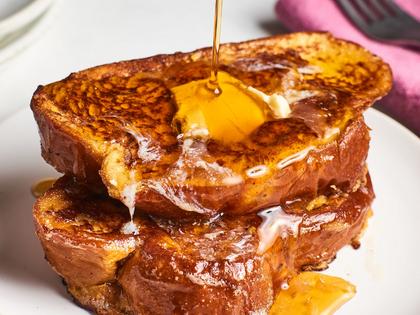The Kitchn: The 4 best types of bread for delicious French toast
French toast is a breakfast staple for the ages. It has a long history and is eaten in many forms all over the world (Spanish torrijas is just one example). When planning your next brunch, you could go in a variety of directions. Should your toast be sweet or savory, cooked on the stovetop or in the oven, served up in slices, baked into a casserole, or even stuffed with ricotta? The choices don’t stop at the recipe. If you’re going to make a great French toast, you’ve also got to choose the right bread for the job.
What is the best bread for French toast?
For a solid French toast, aim for sturdy bread with a uniform texture and a soft crust. Hearty sandwich bread, brioche, challah, and shokupan (Japanese milk bread) are all great choices. Avoid rustic loaves with thick crusts or large holes in the interior.
The myth of stale bread
French toast originated as a way to use up old, stale bread. Today, many French toast recipes advise that it’s best to use stale bread, which can soak up as much custard as possible. However, according to Cook’s Illustrated, most stale bread is not actually dry bread.
Stale bread can feel dry, without actually being dry. Its water has actually been trapped inside of starch crystals in the bread, and can be released by heating it up past 140 degrees. This matters because if you’re trying to make French toast with dry bread, a better method is to dry bread out in a low oven — 15 to 20 minutes in a 300-degree oven should do the trick — instead of, say, leaving it out overnight. In a pinch, you can even use your toaster at a low setting to dry out bread for French toast.
Tips for selecting the best bread for French toast
Choose sturdy bread. French toast is bread soaked in a custard usually made of eggs and milk. The bread you use should be sturdy enough to soak up the liquid without disintegrating.
It should have a tight crumb. Bread with a uniform texture will work best for French toast. Avoid loaves with an irregular, open crumb or lots of holes in the interior.
Look for a loaf with a thin, soft crust. Rustic breads with thick, hard crusts tend to need more soaking time than softer ones to fully absorb custard mixtures. If the crust is very hard or thick, it might not hydrate completely during soaking, leading to dry spots in your finished French toast.
Sandwich bread
Sandwich bread is a French toast classic. It’s a nostalgic favorite for our culinary producer Kelli Foster (of Dinner Therapist fame.) “For me, nothing beats thick slices of white bread for French toast. It needs to be thicker than sandwich bread, for sure. This kind of French toast both reminds me of my childhood and diner-style French toast.”
The light, pillowy texture of sandwich bread can yield super-soft, airy results if you choose the right one. Look for bread that is labeled “hearty,” “thick-cut,” or “Texas toast.” Thin slices are more likely to collapse when soaked. You can also opt for a pullman loaf and slice the bread yourself to your desired thickness. Sliced wheat bread also makes good French toast, but might require a little extra soaking time.
Challah
Denser than sandwich bread, but still soft and pliable, challah is one of the most popular choices for French toast. Challah is a traditional Jewish egg bread. Its flavor lends itself perfectly to a dressed-up custard (we also love it in bread pudding!), and its braided shape makes for especially nice-looking slices.
Brioche
Another gold-standard option, rich brioche is the perfect balance of sturdy texture and soft, uniform crumb. It’s a remarkably versatile bread used for everything from hamburger buns to ice cream sandwiches, and French toast is a great showcase for it. Brioche’s buttery, lightly sweet flavor is a great backbone for sweet or savory French toasts.
Shokupan
Fluffy shokupan is a lightly sweetened white bread that has a soft texture. Much like brioche, its subtle sweetness works very well with the flavors of French toast. Milk bread slices are often on the thicker side, which makes it great for soaking up custard.
(Andrea Rivera is associate food editor at TheKitchn.com, a nationally known blog for people who love food and home cooking. Submit any comments or questions to editorial@thekitchn.com.)
©2024 Apartment Therapy. Distributed by Tribune Content AGency, LLC.











Comments